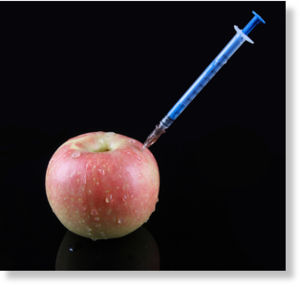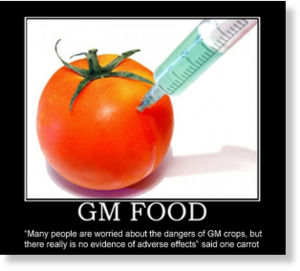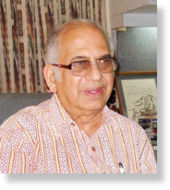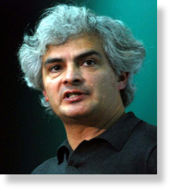Biologist Arpad Pusztai had more than 300 articles and 12 books to his credit and was the world's top expert in his field. But when he accidentally discovered that genetically modified (GM) foods are dangerous, he became the biotech industry's bad-boy poster child, setting an example for other scientists thinking about blowing the whistle.
In the early 1990s, Dr. Pusztai was awarded a $3 million grant by the UK government to design the system for safety-testing genetically modified organisms (GMOs). His team included more than 20 scientists working at three facilities, including the Rowett Institute in Aberdeen, Scotland, the top nutritional research lab in the UK, and his employer for the previous 35 years. The results of Pusztai's work were supposed to become the required testing protocols for all of Europe. But when he fed supposedly harmless GM potatoes to rats, things didn't go as planned.
Within just 10 days, the animals developed potentially pre-cancerous cell growth, smaller brains, livers and testicles, partially atrophied livers, and damaged immune systems. Moreover, the cause was almost certainly side effects from the process of genetic engineering itself. In other words, the GM foods on the market, which are created from the same process, might have similar affects on humans.
With permission from his director, Pusztai was interviewed on TV and expressed his concerns about GM foods. He became a hero at his institute - for two days. Then came the phone calls from the pro-GMO prime minister's office to the institute's director. The next morning, Pusztai was fired. He was silenced with threats of a lawsuit, his team was dismantled, and the protocols never implemented. His institute, the biotech industry, and the UK government, together launched a smear campaign to destroy Pusztai's reputation.

Arpad Pusztai, saw his career runied by big government and big agri-business because he told the truth about GM foodEventually, an invitation to speak before Parliament lifted his gag order and his research was published in the prestigious Lancet. No similar in-depth studies have yet tested the GM foods eaten every day by Americans.
In the early 1990s, Dr. Pusztai was awarded a $3 million grant by the UK government to design the system for safety-testing genetically modified organisms (GMOs). His team included more than 20 scientists working at three facilities, including the Rowett Institute in Aberdeen, Scotland, the top nutritional research lab in the UK, and his employer for the previous 35 years. The results of Pusztai's work were supposed to become the required testing protocols for all of Europe. But when he fed supposedly harmless GM potatoes to rats, things didn't go as planned.
Within just 10 days, the animals developed potentially pre-cancerous cell growth, smaller brains, livers and testicles, partially atrophied livers, and damaged immune systems. Moreover, the cause was almost certainly side effects from the process of genetic engineering itself. In other words, the GM foods on the market, which are created from the same process, might have similar affects on humans.
With permission from his director, Pusztai was interviewed on TV and expressed his concerns about GM foods. He became a hero at his institute - for two days. Then came the phone calls from the pro-GMO prime minister's office to the institute's director. The next morning, Pusztai was fired. He was silenced with threats of a lawsuit, his team was dismantled, and the protocols never implemented. His institute, the biotech industry, and the UK government, together launched a smear campaign to destroy Pusztai's reputation.

Arpad Pusztai, saw his career runied by big government and big agri-business because he told the truth about GM food
Trail of Devastated, Silenced Scientists
The treatment of Dr. Pusztai sent a chilling precedent around the world. By 2001, New Zealand Parliament member Sue Kedgley told the 2001 Royal Commission of Inquiry on Genetic Modification: "Personally I have been contacted by telephone and e-mail by a number of scientists who have serious concerns about aspects of the research that is taking place . . . and the increasingly close ties that are developing between science and commerce, but who are convinced that if they express these fears publicly, even at such a commission. . . or even if they asked the awkward and difficult questions, they will be eased out of their institution."
On September 2, 2009, the prestigious journal Nature acknowledged that the regular attacks on biotech researchers are orchestrated by a "large block of scientists who denigrate research by other legitimate scientists in a knee-jerk, partisan, emotional way that is not helpful in advancing knowledge and is outside the ideals of scientific inquiry."
These attacks have all but stopped independent research into the health and environmental side-effects of GMOs. According to University of California at Berkeley professor Ignacio Chapela, there is a de facto ban on scientists "asking certain questions and finding certain results." He says, "It's very hard for us to publish in this field. People are scared."
 Dr. Charles Benbrook, former Executive Director of the Board on Agriculture of the U.S. National Academy of Sciences, said he has personally spoken with dozens of scientists who "had to contend with this backlash and these counter attacks that the industry unleashes on scientists that they view as a threat. The majority of them get out of the field. The majority of them will not put themselves, or their families, or their career at that kind of risk again." he said.
Dr. Charles Benbrook, former Executive Director of the Board on Agriculture of the U.S. National Academy of Sciences, said he has personally spoken with dozens of scientists who "had to contend with this backlash and these counter attacks that the industry unleashes on scientists that they view as a threat. The majority of them get out of the field. The majority of them will not put themselves, or their families, or their career at that kind of risk again." he said.
Indian Supreme Court Uncovers Regulatory Scam
In February 2008, the Indian Supreme Court asked renowned biologist P. M. Bhargava to evaluate the practices of the Genetic Engineering Approval Committee (GEAC). Dr. Bhargava attended meetings, studied submissions, and consulted more than 600 scientific journals for his analysis. After 10 months he concluded that not only was the Indian approval system inadequate, but no GM crop in the world had ever been properly evaluated. In fact, of the 29 different categories of scientific research that he said should be conducted to protect the environment and public health, only 10% had been addressed. But these studies were industry-funded - designed so poorly that Dr. Bhargava deemed them worthless. He asked the Prime Minister and Health Minister to institute an immediate moratorium on GMOs until adequate tests could be completed.
While attending the GEAC, whenever Dr. Bhargava presented adverse findings about GMOs, the material was summarily dismissed with the statement, "That's been discredited." It didn't matter what prominent journal or highly credentialed scientist had published the work, the response was automatic. When Dr. Bhargava submitted his own report on the GEAC, they tried to discredit him in the same way.
The GEAC attempted to portray him as anti-government, which was ludicrous. Dr. Bhargava had served on over 100 government committees, including the intelligence committee where he had unrestricted access to secret government documents. The GEAC also claimed that he had no experience publishing DNA or RNA research. In reality, Dr. Bhargava had published more relevant papers than all the GEAC members combined.
Dirt Down Under
Epidemiologist Judy Carman used to investigate outbreaks of disease for a state government in Australia. She knows that health problems associated with GM foods might be impossible to track or take decades to discover. Moreover, the superficial, short-term animal feeding studies usually do not evaluate biochemistry, immunology, tissue pathology, gut function, liver function, and kidney function, and are too short to test for cancer or reproductive or child health. Dr. Carman has critiqued the GMO approval process on behalf of the Public Health Association of Australia and speaks openly about her concerns. As a result, she is repeatedly attacked. Pro-GMO scientists threatened disciplinary action through her Vice-Chancellor, and circulated a defamatory letter to government and university officials.
Carman was awarded a grant by the Western Australia government to conduct some of the few long-term animal feeding studies on GMOs. Apparently concerned about what she might find, GMO advocates wrote letters to the government demanding that the grant be withdrawn. One scientist tried to convince the Western Australia Agriculture minister that sufficient safety research had been conducted and he should therefore cancel the grant. As his evidence, however, he presented a report summarizing only 60 GMO animal feeding studies - an infinitesimal amount of research to justify exposing the entire population to GM foods.
A closer investigation, however, revealed that most of the 60 studies were not safety studies at all. They were production studies, measuring, for example, the animals' carcass weight. Only 9 contained data applicable to human health. And 6 of the 9 showed adverse effects in animals that ate GM feed! Furthermore, there were several other studies with adverse findings that were mysteriously missing from the compilation. Carman points out that the report "does not support claims that GM crops are safe to eat. On the contrary, it provides evidence that GM crops may be harmful to health."
When the Western Government refused to withdraw the grant, opponents successfully interfered with Carman's relationship with the university where she was to do the research.
Double Standards
Prominent Norwegian virologist Terje Traavik presented preliminary data at a February 2004 meeting at the UN Biosafety Protocol Conference, showing that:
Birth Defects Courtesy of Monsanto's Roundup
Embryologist Andrés Carrasco is the director of the Laboratory of Molecular Embryology, University of Buenos Aires Medical School, and lead researcher of the National Council of Scientific and Technical Research. In 2010, he discovered that Roundup, the herbicide sold in conjunction with most GM crops, could cause defects in the brain, intestines, and hearts of amphibian fetuses. His results supported the reports of peasants who suffered birth defects after being sprayed by Roundup.
 Monsanto's 'Roundup' weed killer can cause defects in the brain, intestines, and hearts of amphibian fetuses The industry responded by ridiculing the research and even threatening him personally. Four men arrived unannounced at his laboratory and were extremely aggressive, attempting to interrogate Carrasco and search his premises. Later, a violent gang prevented Dr. Carrasco from giving a speech on his findings, beat up his colleagues, and for two hours attacked the car where Dr. Carrasco was holed up.
Monsanto's 'Roundup' weed killer can cause defects in the brain, intestines, and hearts of amphibian fetuses The industry responded by ridiculing the research and even threatening him personally. Four men arrived unannounced at his laboratory and were extremely aggressive, attempting to interrogate Carrasco and search his premises. Later, a violent gang prevented Dr. Carrasco from giving a speech on his findings, beat up his colleagues, and for two hours attacked the car where Dr. Carrasco was holed up.
Threats to Family, Fake Attackers
Ignacio Chapela is a microbial ecologist from UC Berkeley. In 2001, he discovered that the indigenous corn varieties in Mexico - the source of the world's genetic diversity for corn - had become contaminated through cross-pollination with GM varieties. The government had a ban against GM corn to prevent just this possibility, but apparently US corn imported for food had been planted nonetheless.
Dr. Chapela submitted the finding to Nature, and as a courtesy that he later regretted, informed the Mexican government about the pending publication. He was called in to meet with a furious Director of the Commission of Biosafety and GMOs. Chapela's confirmation of contamination would hinder introduction of GM corn. Therefore, the government's top biotech man demanded that he withdraw his article. According to Chapela, the official intimidated and threatened him, even implying, "We know where your children go to school."
When a traumatized Chapela still did not back down, the Underminister for Agriculture later sent him a fax claiming that because of his scientific paper, Chapela would be held personally responsible for all damages caused to agriculture and to the economy in general.
The day Chapela's paper was published, Mary Murphy and Andura Smetacek began posting messages to a biotechnology listserve called AgBioWorld, distributed to more than 3,000 scientists. They falsely claimed that Chapela was biased, that his paper had not been peer-reviewed, that Chapela was "first and foremost an activist," and his research was published in collusion with environmentalists. Soon, hundreds of other messages appeared, repeating or embellishing the accusations. The listserv launched a petition and besieged Nature with a worldwide campaign demanding retraction.
UC Berkeley also received letters from all over the world trying to convince them not to grant Chapela tenure. He had overwhelming support from his college and department, but the international biotech lobby was too much. Chapela's tenure was denied. After he filed a lawsuit, the university eventually reversed its decision.
When investigators later analyzed the email characteristics sent by agitators Mary Murphy and Andura Smetacek, it turned out that the two were not the average citizens they claimed. According to the Guardian, both were fabricated names used by a public relations firm that worked for Monsanto. Some of Smetacek's emails also had the internet protocol address of gatekeeper2.monsanto.com - the server owned by Monsanto.
Denying Access to Seeds
In addition to using threats and other attack strategies, the biotech industry has limited independent research by denying scientists access to their patented seeds. For example:
When Ohio State University plant ecologist Allison Snow discovered problematic side effects in GM sunflowers, Pioneer Hi-Bred International and Dow AgroSciences blocked further research by withholding GM seeds and genes. After Marc Lappé and Britt Bailey found significant reductions in cancer-fighting isoflavones in Monsanto's GM soybeans, the seed seller Hartz told them they could no longer provide samples. Research by a plant geneticist at a leading US university was also thwarted when two companies refused him GM corn. When a Japanese scientist wanted to conduct animal feeding studies on the GM soybeans under review in Japan, both the government and the bean's maker DuPont refused to give him any samples. Hungarian Professor Bela Darvas discovered that Monsanto's GM corn hurt endangered species in his own country. Monsanto immediately shut off his supplies. Dr. Darvas later gave a speech on his preliminary findings and discovered that a false and incriminating report about his research was circulating. He traced it to a Monsanto public relations employee, who claimed that it mysteriously appeared on her desk - so she faxed it out.
Almost no independent studies are conducted. According to a scathing opinion piece in an August 2009 Scientific American, "Agritech companies have given themselves veto power over the work of independent researchers. . . . Only studies that the seed companies have approved ever see the light of a peer-reviewed journal."
A group of 26 insect scientists protested this restriction in a letter submitted to the Environmental Protection Agency. They warned that the inability to access GM seeds from biotech companies means there can be no truly independent research on the critical questions. The scientists, of course, withheld their identities for fear of reprisals from the companies.
The treatment of Dr. Pusztai sent a chilling precedent around the world. By 2001, New Zealand Parliament member Sue Kedgley told the 2001 Royal Commission of Inquiry on Genetic Modification: "Personally I have been contacted by telephone and e-mail by a number of scientists who have serious concerns about aspects of the research that is taking place . . . and the increasingly close ties that are developing between science and commerce, but who are convinced that if they express these fears publicly, even at such a commission. . . or even if they asked the awkward and difficult questions, they will be eased out of their institution."
On September 2, 2009, the prestigious journal Nature acknowledged that the regular attacks on biotech researchers are orchestrated by a "large block of scientists who denigrate research by other legitimate scientists in a knee-jerk, partisan, emotional way that is not helpful in advancing knowledge and is outside the ideals of scientific inquiry."
These attacks have all but stopped independent research into the health and environmental side-effects of GMOs. According to University of California at Berkeley professor Ignacio Chapela, there is a de facto ban on scientists "asking certain questions and finding certain results." He says, "It's very hard for us to publish in this field. People are scared."

Scientists involved in research on the effects of GMOs are being threatened and fired from their jobs!
Indian Supreme Court Uncovers Regulatory Scam
In February 2008, the Indian Supreme Court asked renowned biologist P. M. Bhargava to evaluate the practices of the Genetic Engineering Approval Committee (GEAC). Dr. Bhargava attended meetings, studied submissions, and consulted more than 600 scientific journals for his analysis. After 10 months he concluded that not only was the Indian approval system inadequate, but no GM crop in the world had ever been properly evaluated. In fact, of the 29 different categories of scientific research that he said should be conducted to protect the environment and public health, only 10% had been addressed. But these studies were industry-funded - designed so poorly that Dr. Bhargava deemed them worthless. He asked the Prime Minister and Health Minister to institute an immediate moratorium on GMOs until adequate tests could be completed.
While attending the GEAC, whenever Dr. Bhargava presented adverse findings about GMOs, the material was summarily dismissed with the statement, "That's been discredited." It didn't matter what prominent journal or highly credentialed scientist had published the work, the response was automatic. When Dr. Bhargava submitted his own report on the GEAC, they tried to discredit him in the same way.
The GEAC attempted to portray him as anti-government, which was ludicrous. Dr. Bhargava had served on over 100 government committees, including the intelligence committee where he had unrestricted access to secret government documents. The GEAC also claimed that he had no experience publishing DNA or RNA research. In reality, Dr. Bhargava had published more relevant papers than all the GEAC members combined.
Dirt Down Under
Epidemiologist Judy Carman used to investigate outbreaks of disease for a state government in Australia. She knows that health problems associated with GM foods might be impossible to track or take decades to discover. Moreover, the superficial, short-term animal feeding studies usually do not evaluate biochemistry, immunology, tissue pathology, gut function, liver function, and kidney function, and are too short to test for cancer or reproductive or child health. Dr. Carman has critiqued the GMO approval process on behalf of the Public Health Association of Australia and speaks openly about her concerns. As a result, she is repeatedly attacked. Pro-GMO scientists threatened disciplinary action through her Vice-Chancellor, and circulated a defamatory letter to government and university officials.
Carman was awarded a grant by the Western Australia government to conduct some of the few long-term animal feeding studies on GMOs. Apparently concerned about what she might find, GMO advocates wrote letters to the government demanding that the grant be withdrawn. One scientist tried to convince the Western Australia Agriculture minister that sufficient safety research had been conducted and he should therefore cancel the grant. As his evidence, however, he presented a report summarizing only 60 GMO animal feeding studies - an infinitesimal amount of research to justify exposing the entire population to GM foods.
A closer investigation, however, revealed that most of the 60 studies were not safety studies at all. They were production studies, measuring, for example, the animals' carcass weight. Only 9 contained data applicable to human health. And 6 of the 9 showed adverse effects in animals that ate GM feed! Furthermore, there were several other studies with adverse findings that were mysteriously missing from the compilation. Carman points out that the report "does not support claims that GM crops are safe to eat. On the contrary, it provides evidence that GM crops may be harmful to health."
When the Western Government refused to withdraw the grant, opponents successfully interfered with Carman's relationship with the university where she was to do the research.
Double Standards
Prominent Norwegian virologist Terje Traavik presented preliminary data at a February 2004 meeting at the UN Biosafety Protocol Conference, showing that:
- Filipinos living next to a GM cornfield developed serious symptoms while the corn was pollinating;
- Genetic material inserted into GM crops was transferred to rat organs after a single meal;
- Key safety assumptions about genetically engineered viruses were overturned, calling into question the safety of using these viruses in vaccines.
Birth Defects Courtesy of Monsanto's Roundup
Embryologist Andrés Carrasco is the director of the Laboratory of Molecular Embryology, University of Buenos Aires Medical School, and lead researcher of the National Council of Scientific and Technical Research. In 2010, he discovered that Roundup, the herbicide sold in conjunction with most GM crops, could cause defects in the brain, intestines, and hearts of amphibian fetuses. His results supported the reports of peasants who suffered birth defects after being sprayed by Roundup.
 Monsanto's 'Roundup' weed killer can cause defects in the brain, intestines, and hearts of amphibian fetuses
Monsanto's 'Roundup' weed killer can cause defects in the brain, intestines, and hearts of amphibian fetusesThreats to Family, Fake Attackers
Ignacio Chapela is a microbial ecologist from UC Berkeley. In 2001, he discovered that the indigenous corn varieties in Mexico - the source of the world's genetic diversity for corn - had become contaminated through cross-pollination with GM varieties. The government had a ban against GM corn to prevent just this possibility, but apparently US corn imported for food had been planted nonetheless.
Dr. Chapela submitted the finding to Nature, and as a courtesy that he later regretted, informed the Mexican government about the pending publication. He was called in to meet with a furious Director of the Commission of Biosafety and GMOs. Chapela's confirmation of contamination would hinder introduction of GM corn. Therefore, the government's top biotech man demanded that he withdraw his article. According to Chapela, the official intimidated and threatened him, even implying, "We know where your children go to school."
When a traumatized Chapela still did not back down, the Underminister for Agriculture later sent him a fax claiming that because of his scientific paper, Chapela would be held personally responsible for all damages caused to agriculture and to the economy in general.
The day Chapela's paper was published, Mary Murphy and Andura Smetacek began posting messages to a biotechnology listserve called AgBioWorld, distributed to more than 3,000 scientists. They falsely claimed that Chapela was biased, that his paper had not been peer-reviewed, that Chapela was "first and foremost an activist," and his research was published in collusion with environmentalists. Soon, hundreds of other messages appeared, repeating or embellishing the accusations. The listserv launched a petition and besieged Nature with a worldwide campaign demanding retraction.
UC Berkeley also received letters from all over the world trying to convince them not to grant Chapela tenure. He had overwhelming support from his college and department, but the international biotech lobby was too much. Chapela's tenure was denied. After he filed a lawsuit, the university eventually reversed its decision.
When investigators later analyzed the email characteristics sent by agitators Mary Murphy and Andura Smetacek, it turned out that the two were not the average citizens they claimed. According to the Guardian, both were fabricated names used by a public relations firm that worked for Monsanto. Some of Smetacek's emails also had the internet protocol address of gatekeeper2.monsanto.com - the server owned by Monsanto.
Denying Access to Seeds
In addition to using threats and other attack strategies, the biotech industry has limited independent research by denying scientists access to their patented seeds. For example:
When Ohio State University plant ecologist Allison Snow discovered problematic side effects in GM sunflowers, Pioneer Hi-Bred International and Dow AgroSciences blocked further research by withholding GM seeds and genes. After Marc Lappé and Britt Bailey found significant reductions in cancer-fighting isoflavones in Monsanto's GM soybeans, the seed seller Hartz told them they could no longer provide samples. Research by a plant geneticist at a leading US university was also thwarted when two companies refused him GM corn. When a Japanese scientist wanted to conduct animal feeding studies on the GM soybeans under review in Japan, both the government and the bean's maker DuPont refused to give him any samples. Hungarian Professor Bela Darvas discovered that Monsanto's GM corn hurt endangered species in his own country. Monsanto immediately shut off his supplies. Dr. Darvas later gave a speech on his preliminary findings and discovered that a false and incriminating report about his research was circulating. He traced it to a Monsanto public relations employee, who claimed that it mysteriously appeared on her desk - so she faxed it out.
Almost no independent studies are conducted. According to a scathing opinion piece in an August 2009 Scientific American, "Agritech companies have given themselves veto power over the work of independent researchers. . . . Only studies that the seed companies have approved ever see the light of a peer-reviewed journal."
A group of 26 insect scientists protested this restriction in a letter submitted to the Environmental Protection Agency. They warned that the inability to access GM seeds from biotech companies means there can be no truly independent research on the critical questions. The scientists, of course, withheld their identities for fear of reprisals from the companies.
Researchers have been denied access to GMO seeds for testing
French Professor G. E. Seralini has conducted pivotal research that highlights adverse health effects from GM plants and the associated herbicide Roundup, including endocrine disruption, toxicity, and immune responses. He also identified unreported side-effects in Monsanto's own rat studies that were hidden in the company's dubious statistics. Seralini was, of course, attacked by GMO advocates. But they picked the wrong guy. He sued his detractor last year for libel, and in January of this year was declared victorious by the French courts.
Doctor's Orders
In spite of the lack of independent studies, there is already significant evidence that GMOs are harmful. Citing results from animal feeding studies such as reproductive disorders, organ damage, accelerated aging, gastrointestinal problems, and immune system dysfunction, the American Academy of Environmental Medicine now urges all doctors to prescribe non-GMO diets. Of course, following the doctors' orders can be difficult, since the US is one of the only industrialized nations that do not require labeling of GMOs. That's because the person in charge of GMO policy at the FDA was the former attorney for biotech giant Monsanto, and later their vice-president. Now he's back at the FDA as US Food Safety Czar.
His policy also ignored the overwhelming consensus among FDA scientists, warning about potential dangers and urging caution and rigorous testing requirements. Instead, the policy of the FDA does not require a single safety test, and allows Monsanto - the company that told us PCBs, Agent Orange, and DDT were safe - to determine if it's GMOs are safe.
Fortunately, there are thousands of products that are voluntarily labeled as non-GMO. You can find them at NonGMOShoppingGuide.com.
Safe eating!
About the author: Jeffrey M. Smith is the Founder of the Institute for Responsible Technology (www.responsibletechnology.org) and the international bestselling author of Seeds of Deception and Genetic Roulette. His organization has started the Campaign for Healthier Eating in America, designed to create a tipping point of consumer rejection - to force GMOs out of the market.
French Professor G. E. Seralini has conducted pivotal research that highlights adverse health effects from GM plants and the associated herbicide Roundup, including endocrine disruption, toxicity, and immune responses. He also identified unreported side-effects in Monsanto's own rat studies that were hidden in the company's dubious statistics. Seralini was, of course, attacked by GMO advocates. But they picked the wrong guy. He sued his detractor last year for libel, and in January of this year was declared victorious by the French courts.
Doctor's Orders
In spite of the lack of independent studies, there is already significant evidence that GMOs are harmful. Citing results from animal feeding studies such as reproductive disorders, organ damage, accelerated aging, gastrointestinal problems, and immune system dysfunction, the American Academy of Environmental Medicine now urges all doctors to prescribe non-GMO diets. Of course, following the doctors' orders can be difficult, since the US is one of the only industrialized nations that do not require labeling of GMOs. That's because the person in charge of GMO policy at the FDA was the former attorney for biotech giant Monsanto, and later their vice-president. Now he's back at the FDA as US Food Safety Czar.
His policy also ignored the overwhelming consensus among FDA scientists, warning about potential dangers and urging caution and rigorous testing requirements. Instead, the policy of the FDA does not require a single safety test, and allows Monsanto - the company that told us PCBs, Agent Orange, and DDT were safe - to determine if it's GMOs are safe.
Fortunately, there are thousands of products that are voluntarily labeled as non-GMO. You can find them at NonGMOShoppingGuide.com.
Safe eating!
About the author: Jeffrey M. Smith is the Founder of the Institute for Responsible Technology (www.responsibletechnology.org) and the international bestselling author of Seeds of Deception and Genetic Roulette. His organization has started the Campaign for Healthier Eating in America, designed to create a tipping point of consumer rejection - to force GMOs out of the market.




